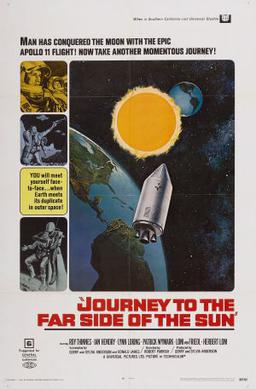 In the year 2069, the European Space Exploration Council discovers that there is a planet on the other side of the Sun, one that orbits the same path as the Earth. Unfortunately, a spy transmits this information to the communists so America and Europe team up to make sure that they reach the planet before the Russians!
In the year 2069, the European Space Exploration Council discovers that there is a planet on the other side of the Sun, one that orbits the same path as the Earth. Unfortunately, a spy transmits this information to the communists so America and Europe team up to make sure that they reach the planet before the Russians!
(Remember, production started on this movie in 1967, when America and Soviet Union were still competing to see who would be the first to land on the moon. Of course, by the time Journey to the Far Side of the Sun was released in 1969, America had already landed on the moon and the Russian space program was no longer taken seriously.)
Two astronauts are assigned to a manned mission to explore the new planet. Glenn Ross (Roy Thinnes) is American. John Kane (Ian Hendry) is British. After spending three weeks in suspended animation, Ross and Kane awaken to discover themselves orbiting a planet that appears to have much the same atmosphere as Earth. When their ship crashes into the planet, Kane is fatally injured and Ross is retrieved by a human rescue team! He’s told that the ship crashed in Mongolia. Kane and Ross were orbiting Earth all along!
Or were they? Even though Ross is reunited with his wife and debriefed by Jason Webb (Patrick Wymark), the head of the mission, he soon discovers that things are different. People who were once right-handed are now left-handed and text is now written from right-to-left instead of left-to-right. People drive on the wrong side of the road and, after Ross makes love to his wife, she feels like something was different about him. Ross realizes that he’s on a counter-Earth!
It’s an intriguing premise but, unfortunately, Journey to the Far Side of the Sun doesn’t do much with it. It’s not as if Ross has landed on the Bizarro world, where people say, “Bad Bye” and root for the bad guys at the movies. Instead, it’s just a world where right-handed people are now left-handed and everyone drives on the opposite side of the road. Ross theorizes that everything that happens on Earth also happens on Counter-Earth, which means that the other Ross is on Earth, realizing the exact same thing that the first Ross is realizing but who cares because there’s not really any major differences between the two Earths. Maybe if Counter-Earth had an alternate history where Rome never fell or the Germans won World War II, the movie would be more interesting or at least more like an old episode of Star Trek. Instead, the movie is all about Ross trying to convince the people on Counter-Earth that he didn’t intentionally abort the mission and that he should be given a chance to return to his Earth. It’s the driest possible way to approach an interesting premise.
I will say that Journey to the Far Side of the Sun also has one of the strangest endings that I’ve ever seen. I won’t spoil it here, other than to say that I wonder if the ending was written before or after 2001 made confusing conclusions cool again.
Pingback: Lisa’s Week In Review: 3/2/20 — 3/8/20 | Through the Shattered Lens